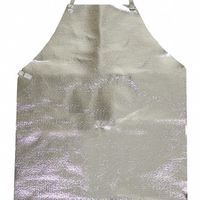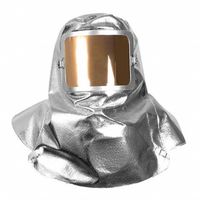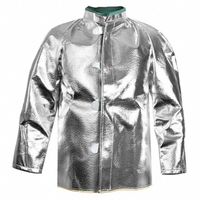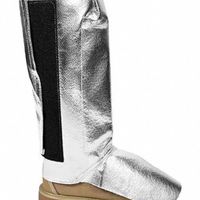Call +(254) 703 030 000 / 751 483 999 / 721 704 777
- Home
- Safety
- Protective Clothing
- Aluminized Heat Resistant Clothing
.....Read More
Frequently Asked Questions
What is aluminized heat-resistant clothing?
Aluminized heat-resistant clothing is specialized protective apparel designed to shield individuals from extreme heat and fire hazards. This type of clothing is typically used in environments where workers are exposed to high temperatures, such as foundries, steel mills, and firefighting operations. The key feature of aluminized clothing is its outer layer, which is coated with a thin layer of aluminum. This aluminum coating reflects radiant heat, thereby reducing the amount of heat that penetrates the garment and reaches the wearer.
The clothing is usually made from a combination of materials that provide both thermal insulation and durability. Common base materials include aramid fibers like Kevlar or Nomex, which are known for their heat resistance and strength. The aluminized layer is bonded to these fabrics to enhance their protective capabilities.
Aluminized heat-resistant clothing comes in various forms, including jackets, pants, aprons, gloves, and full-body suits, allowing for comprehensive protection depending on the specific needs of the job. These garments are designed to be lightweight and flexible, ensuring that the wearer can move freely while still being protected.
In addition to reflecting radiant heat, aluminized clothing also provides protection against molten metal splashes, sparks, and other fire-related hazards. The garments are often tested to meet specific safety standards, ensuring they provide adequate protection in hazardous environments.
Overall, aluminized heat-resistant clothing is an essential component of personal protective equipment (PPE) for workers in high-temperature industries, offering a critical layer of defense against the dangers of extreme heat and fire.
How does aluminized clothing protect against radiant heat?
Aluminized clothing protects against radiant heat primarily through its reflective properties. The outer layer of this specialized clothing is coated with a thin layer of aluminum, which has a high reflectivity for infrared radiation, the primary component of radiant heat. This reflective surface can deflect up to 95% of the radiant heat away from the wearer, significantly reducing the amount of heat absorbed by the body.
The aluminum coating acts as a mirror for thermal radiation, bouncing the heat waves back towards the source rather than allowing them to penetrate the fabric. This is crucial in environments where workers are exposed to high temperatures, such as in foundries, steel mills, or during firefighting operations. By reflecting the radiant heat, aluminized clothing helps maintain a safer and more comfortable temperature for the wearer, preventing heat stress and burns.
Additionally, aluminized clothing often incorporates multiple layers, including insulating materials beneath the reflective surface. These layers provide further protection by reducing conductive and convective heat transfer. The insulation traps air, which is a poor conductor of heat, thereby enhancing the garment's overall thermal resistance.
The design of aluminized clothing also considers factors like fit and coverage to ensure maximum protection. Garments are typically loose-fitting to allow for air circulation, which aids in cooling and further reduces heat transfer to the skin.
In summary, aluminized clothing protects against radiant heat through its reflective aluminum surface, which deflects the majority of thermal radiation, combined with insulating layers that minimize heat transfer, ensuring the safety and comfort of individuals working in high-temperature environments.
What materials are used in aluminized heat-resistant clothing?
Aluminized heat-resistant clothing is designed to protect individuals from extreme heat and is commonly used in industries such as firefighting, metalworking, and foundries. The primary materials used in these garments include:
1. **Aluminized Fabric**: The outer layer is typically made from a base fabric, such as aramid (e.g., Kevlar or Nomex), fiberglass, or carbon-based materials, which is then coated or laminated with a thin layer of aluminum. The aluminum reflects radiant heat, providing a barrier against high temperatures.
2. **Aramid Fibers**: Aramid fibers like Kevlar and Nomex are used for their high strength, flame resistance, and thermal stability. These fibers do not melt or ignite in normal levels of oxygen, making them ideal for heat-resistant clothing.
3. **Fiberglass**: This material is often used for its excellent thermal insulation properties. It can withstand high temperatures and provides a durable base for the aluminized coating.
4. **Carbon-Based Materials**: Carbon fibers are sometimes used for their high thermal resistance and strength. They are lightweight and can withstand extreme temperatures without degrading.
5. **Insulating Layers**: Beneath the aluminized outer layer, additional insulating materials may be used to enhance thermal protection. These can include layers of wool, felt, or other non-flammable insulating fabrics.
6. **Moisture Barriers**: Some garments incorporate moisture barriers to protect against steam and hot liquid splashes. These barriers are often made from materials like PTFE (polytetrafluoroethylene).
7. **Protective Coatings**: Additional coatings may be applied to enhance durability, abrasion resistance, and protection against chemical exposure.
These materials work together to provide comprehensive protection against heat, flames, and molten metal splashes, ensuring the safety of individuals working in high-temperature environments.
Can aluminized clothing protect against molten metal splash?
Yes, aluminized clothing can protect against molten metal splash. Aluminized clothing is specifically designed to provide thermal protection in environments where workers are exposed to high temperatures and molten metal. The outer layer of this clothing is coated with aluminum, which reflects radiant heat and provides a barrier against molten metal splashes.
The key features that make aluminized clothing effective include:
1. **Reflective Surface**: The aluminum coating reflects a significant portion of radiant heat, reducing the amount of heat absorbed by the wearer. This is crucial in environments with high radiant heat, such as foundries and metalworking facilities.
2. **Thermal Insulation**: Beneath the aluminized layer, these garments often have insulating materials that provide additional protection against heat transfer, helping to maintain a safe temperature for the wearer.
3. **Molten Metal Resistance**: The smooth surface of the aluminized layer helps molten metal to slide off rather than adhere to the fabric, minimizing the risk of burns.
4. **Durability and Flexibility**: Aluminized clothing is designed to withstand harsh conditions while allowing for sufficient mobility, ensuring that workers can perform their tasks without restriction.
5. **Compliance with Safety Standards**: These garments are typically tested and certified to meet industry safety standards, ensuring they provide adequate protection against specific hazards like molten metal splash.
While aluminized clothing offers significant protection, it is essential to ensure that it is used correctly and maintained properly. Regular inspections for damage and proper fit are crucial to maintaining its protective capabilities. Additionally, it should be part of a comprehensive safety program that includes other personal protective equipment (PPE) and safety protocols.
What are the different types of aluminized clothing available?
Aluminized clothing is designed to protect workers from extreme heat and molten metal splash. The different types of aluminized clothing include:
1. **Aluminized Jackets and Coats**: These provide upper body protection and are often used in environments with high radiant heat. They are typically made with a layer of aluminum on the outside to reflect heat away from the body.
2. **Aluminized Pants and Bib Overalls**: These garments protect the lower body and are often worn in conjunction with jackets or coats. They are designed to offer flexibility and comfort while ensuring safety from heat exposure.
3. **Aluminized Aprons**: Used for frontal protection, these are ideal for tasks that involve facing heat sources directly. They are often used in foundries and metalworking industries.
4. **Aluminized Hoods**: These provide head and neck protection and often include a face shield to protect against radiant heat and molten metal splashes. They are essential for tasks that require close proximity to intense heat.
5. **Aluminized Gloves and Mitts**: Designed to protect hands from heat and molten metal, these are crucial for handling hot materials. They often feature additional insulation for enhanced protection.
6. **Aluminized Leggings and Spats**: These protect the lower legs and feet from heat and are often used in conjunction with other aluminized clothing for full-body protection.
7. **Aluminized Sleeves**: These offer additional protection for the arms and are often used when full jackets are not necessary.
8. **Aluminized Boot Covers**: Designed to protect footwear from heat and molten metal, these are essential in environments where the risk of foot exposure to heat is high.
Each type of aluminized clothing is designed to provide specific protection based on the needs of the work environment, ensuring safety and comfort for workers exposed to high temperatures.
How should aluminized clothing be maintained or cleaned?
Aluminized clothing, designed for high-heat environments, requires specific maintenance to ensure its protective qualities and longevity. Here’s how to maintain and clean it:
1. **Inspection**: Regularly inspect the clothing for any signs of damage, such as tears, abrasions, or delamination of the aluminized layer. Replace any damaged garments immediately to ensure safety.
2. **Cleaning**:
- **Hand Washing**: Use mild detergent and lukewarm water. Gently scrub the surface with a soft brush or sponge to remove dirt and contaminants. Avoid harsh chemicals or bleach, as they can degrade the aluminized layer.
- **Machine Washing**: If machine washing is necessary, use a gentle cycle with cold water and mild detergent. Place the clothing in a mesh laundry bag to protect it from mechanical damage.
- **Rinsing**: Thoroughly rinse the clothing to remove all detergent residues, which can affect the material's reflective properties.
3. **Drying**:
- Air dry the clothing by hanging it in a well-ventilated area, away from direct sunlight or heat sources, which can cause the material to warp or degrade.
- Avoid using a tumble dryer, as the heat can damage the aluminized coating.
4. **Storage**: Store the clothing in a cool, dry place, away from direct sunlight and chemicals. Hang the garments to prevent creasing and maintain their shape.
5. **Handling**: Handle the clothing with clean hands to prevent transferring oils or contaminants. Avoid contact with sharp objects that could puncture or tear the material.
6. **Professional Cleaning**: For stubborn stains or extensive cleaning, consider professional cleaning services that specialize in protective clothing.
By following these guidelines, aluminized clothing can be effectively maintained, ensuring its protective capabilities and extending its service life.
Is aluminized clothing suitable for all high-temperature environments?
Aluminized clothing is not suitable for all high-temperature environments. While it is designed to protect against radiant heat and molten metal splash, its effectiveness depends on the specific conditions and hazards present in the environment.
Aluminized clothing is typically used in industries such as foundries, metalworking, and firefighting, where workers are exposed to intense radiant heat. The aluminized surface reflects a significant portion of this heat, providing a barrier that helps maintain a safer temperature for the wearer. However, it is not inherently flame-resistant and may not provide adequate protection in environments with direct flame exposure or where there is a risk of chemical exposure.
In environments where there is a risk of direct flame contact, such as in firefighting or certain industrial processes, additional flame-resistant materials are necessary to ensure safety. Aluminized clothing can be part of a layered protective system but should not be relied upon as the sole protective measure in such scenarios.
Moreover, aluminized clothing can be heavy and may restrict movement, which can be a disadvantage in environments requiring agility and quick response. It is also not suitable for environments with electrical hazards, as the metallic surface can conduct electricity.
In summary, while aluminized clothing is effective for specific high-temperature environments, it is not universally suitable for all such conditions. The choice of protective clothing should be based on a comprehensive assessment of the specific hazards present, including radiant heat, direct flame, chemical exposure, and electrical risks, to ensure the safety and effectiveness of the protective gear.




